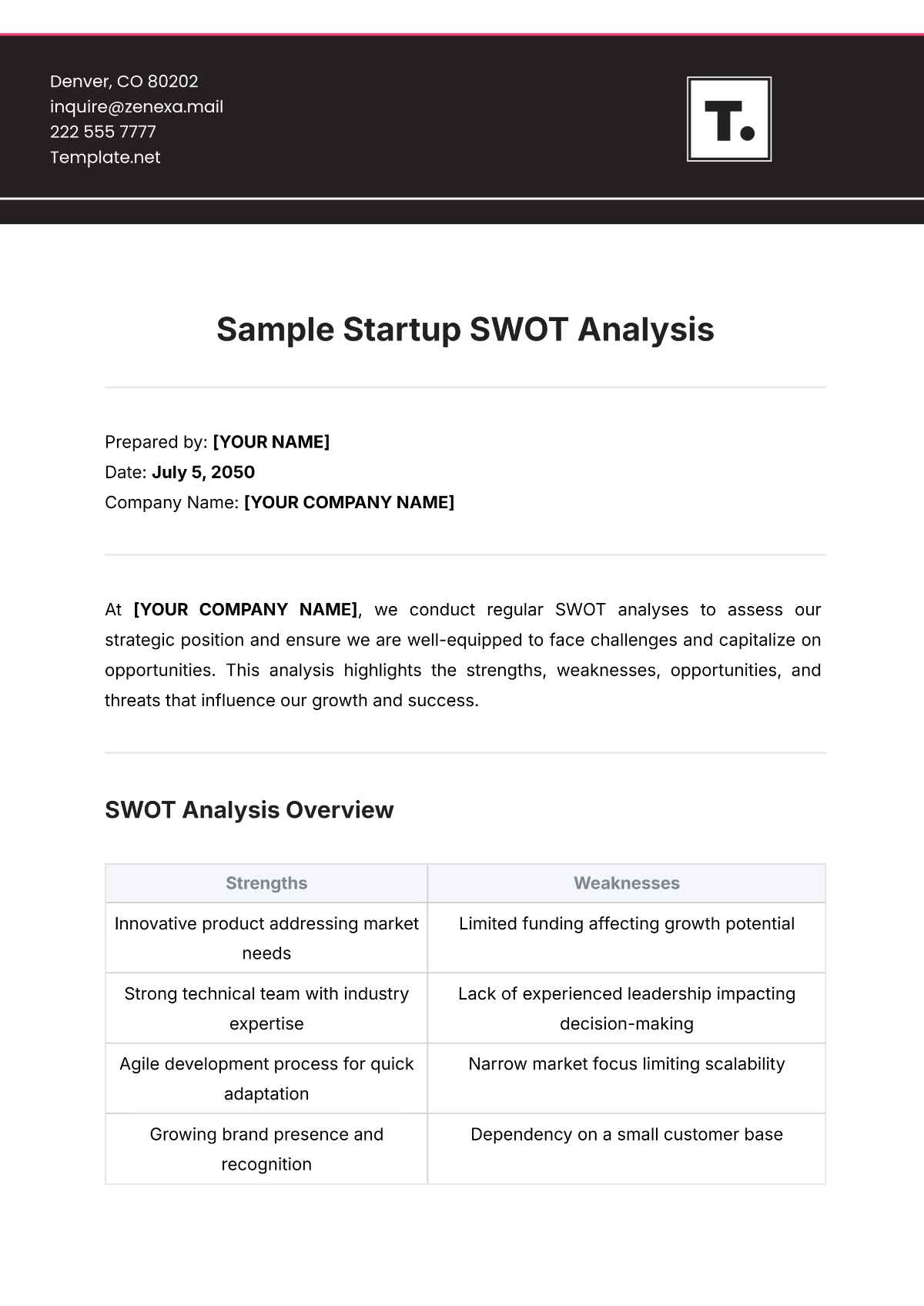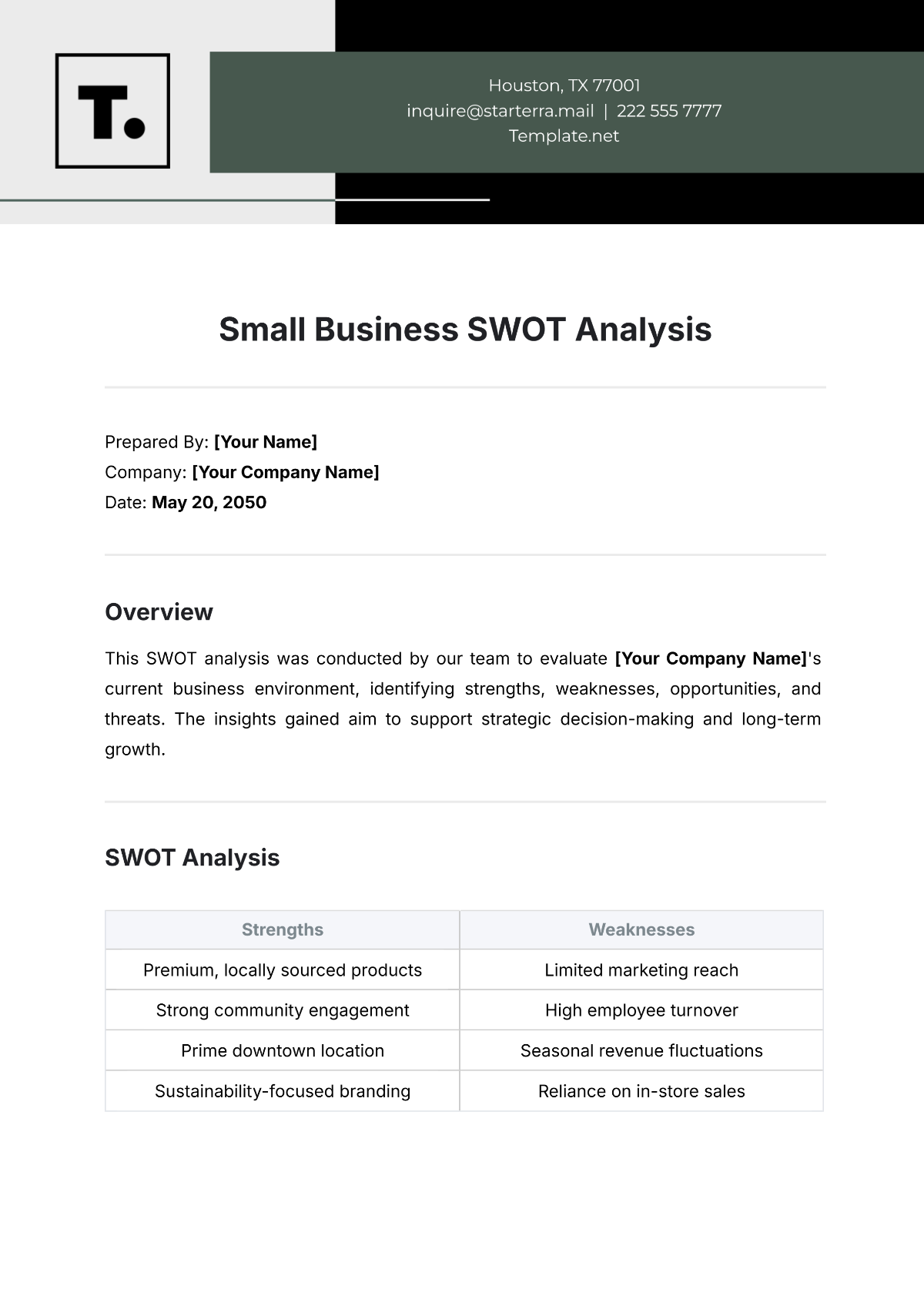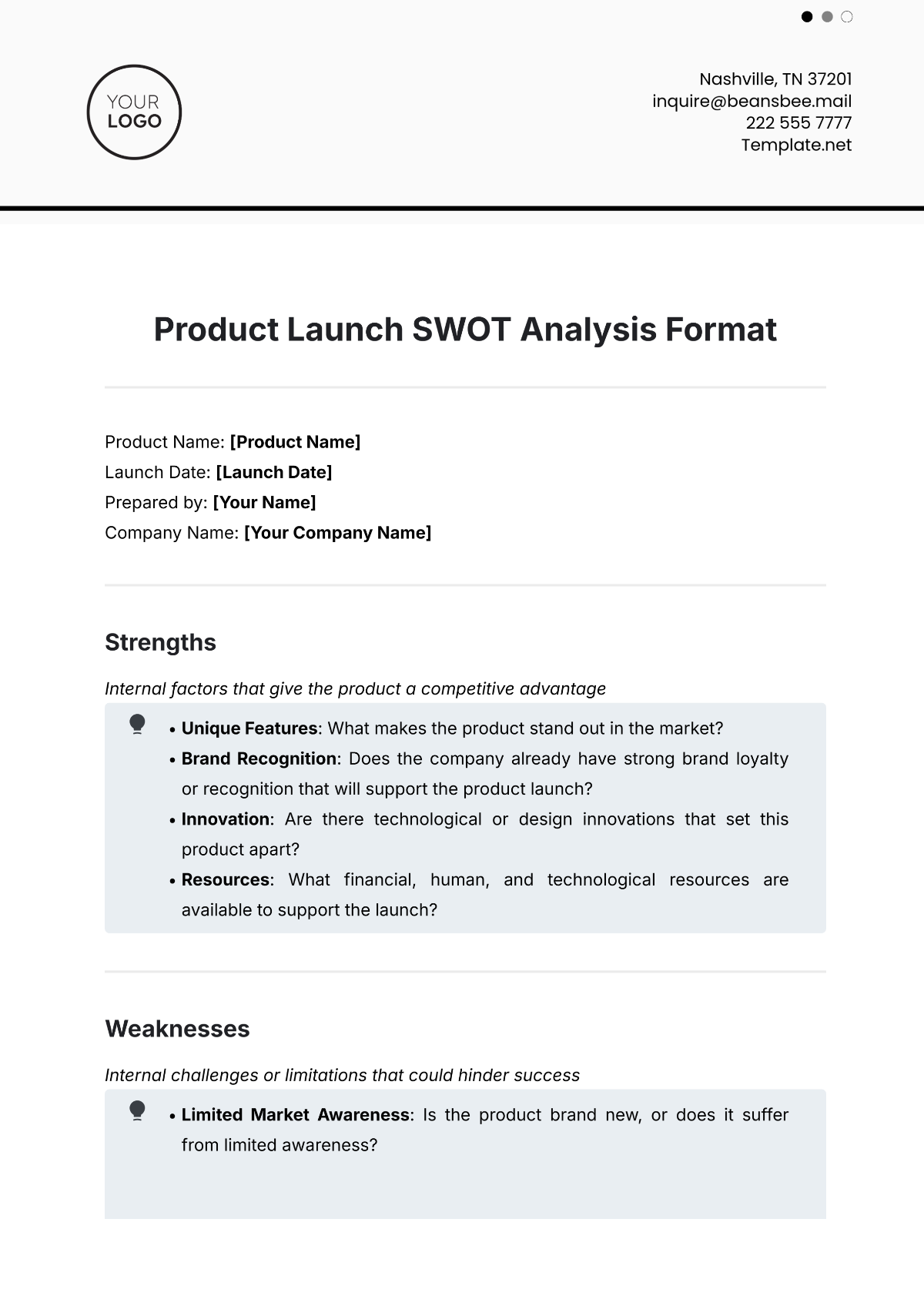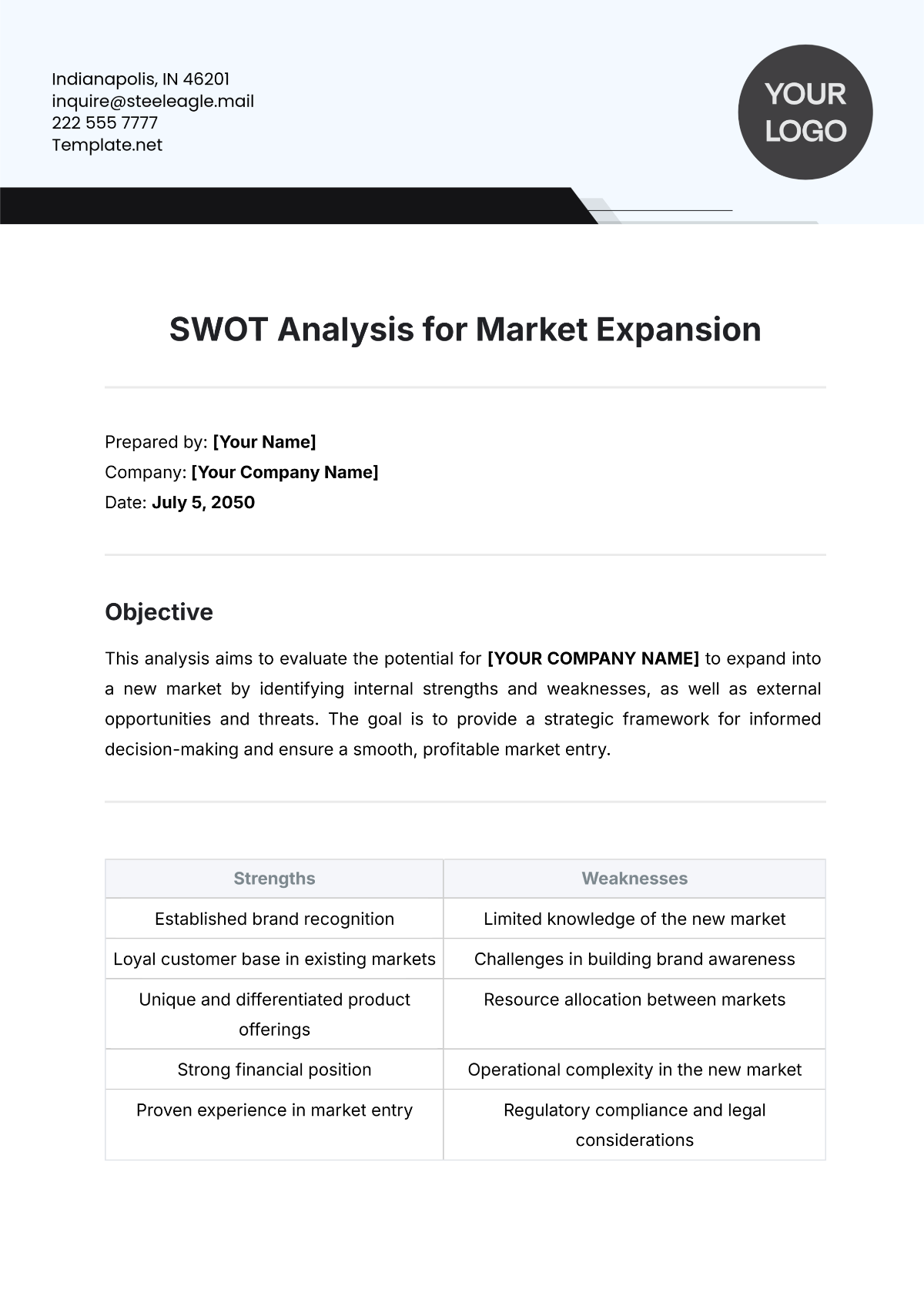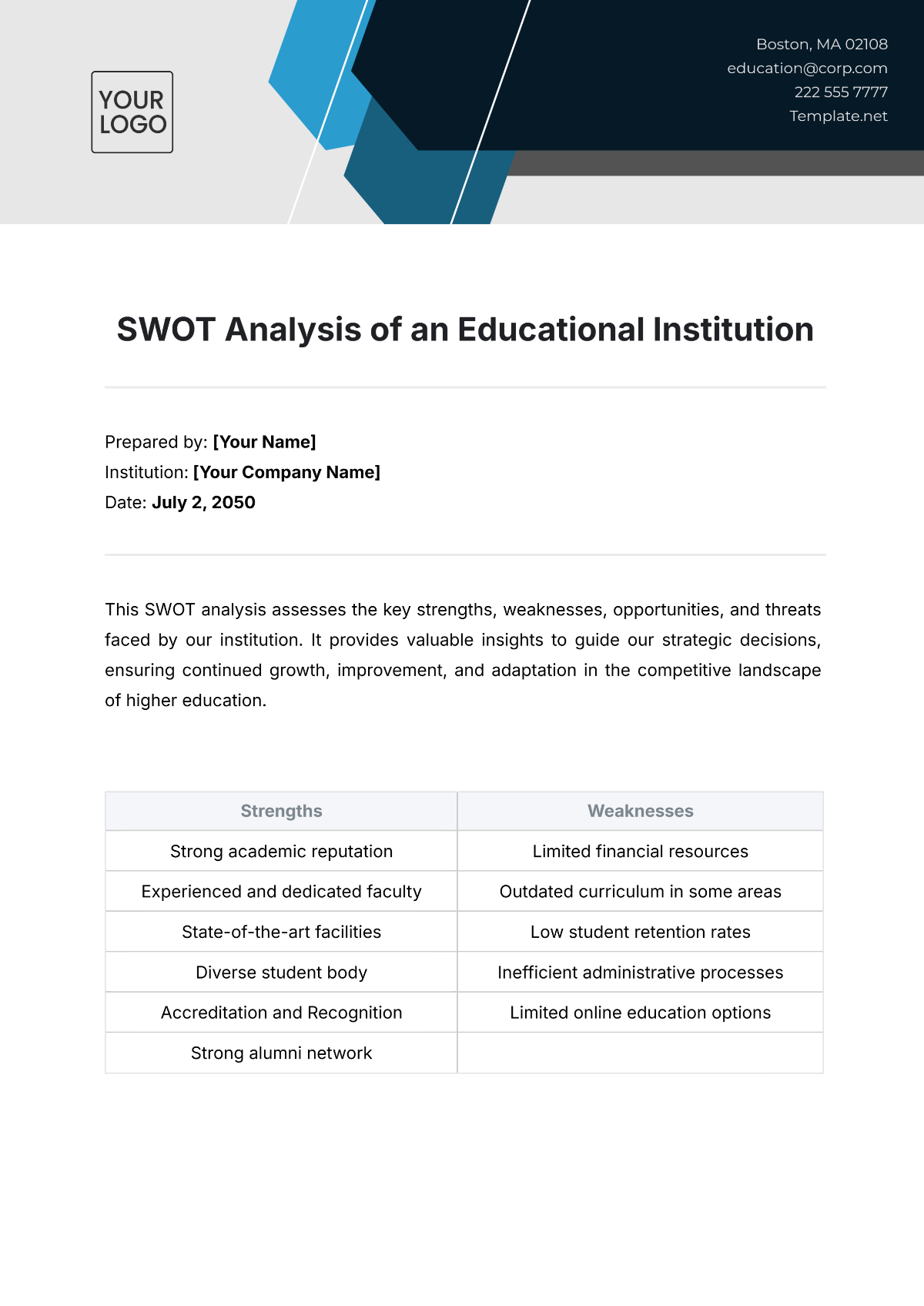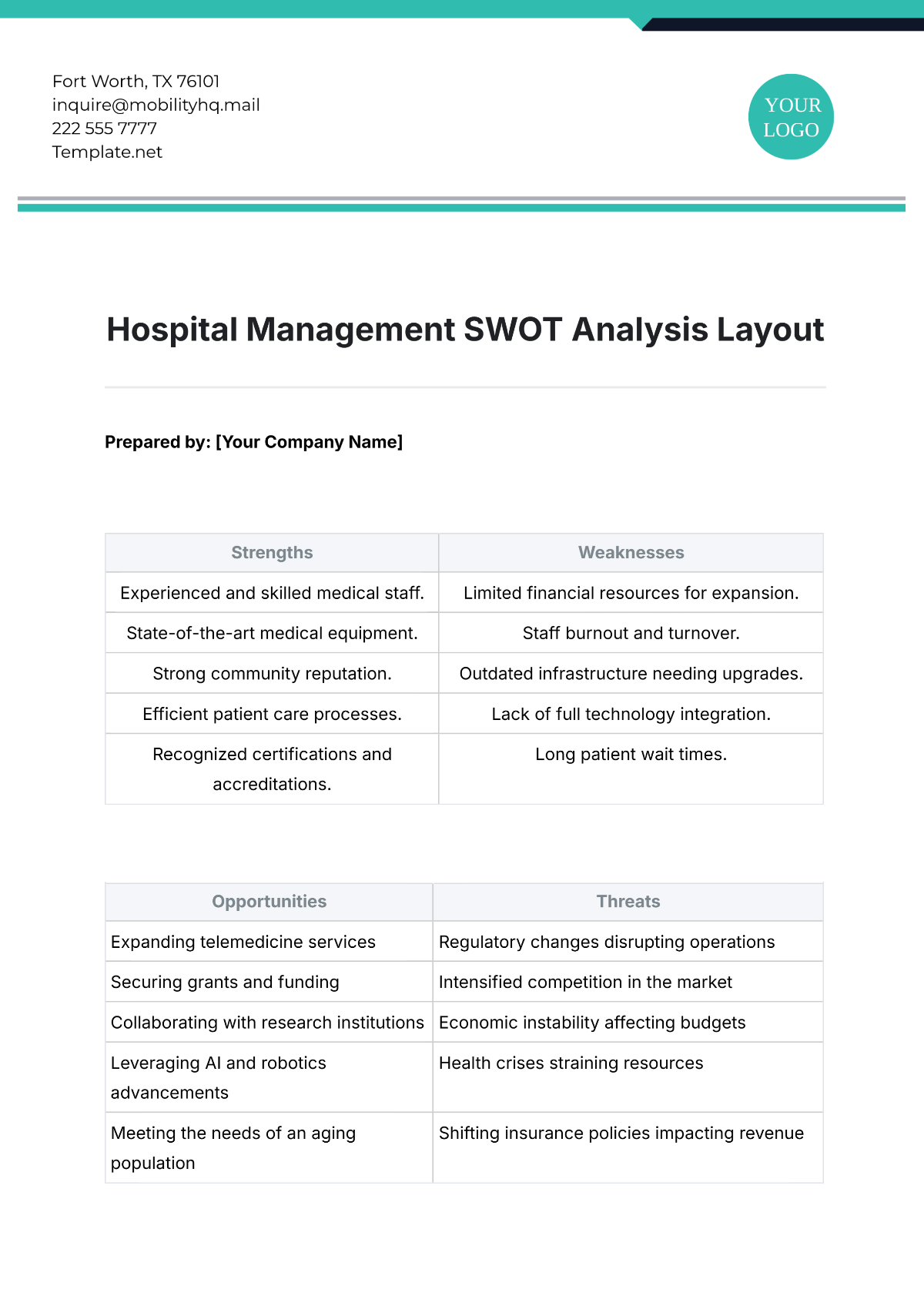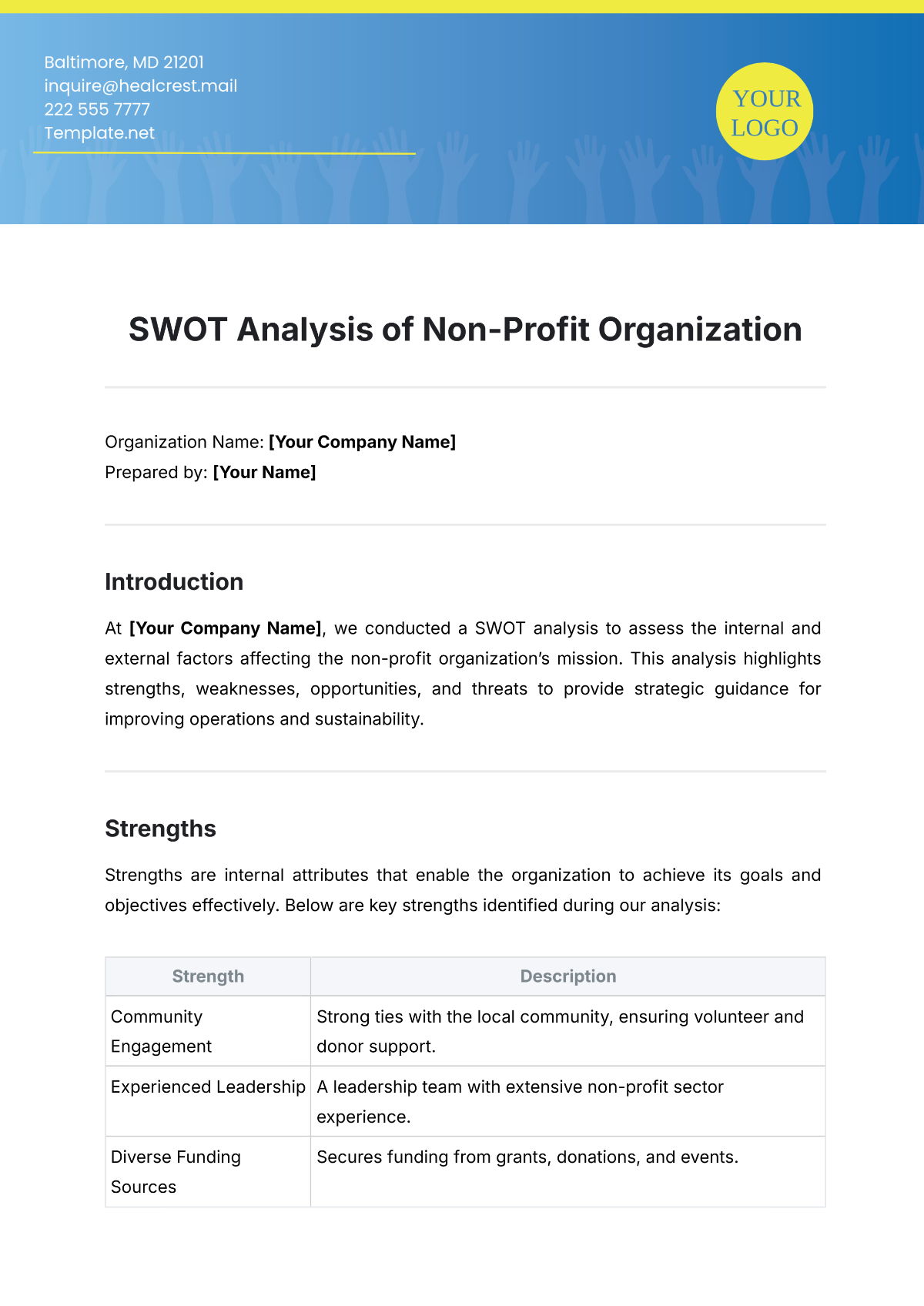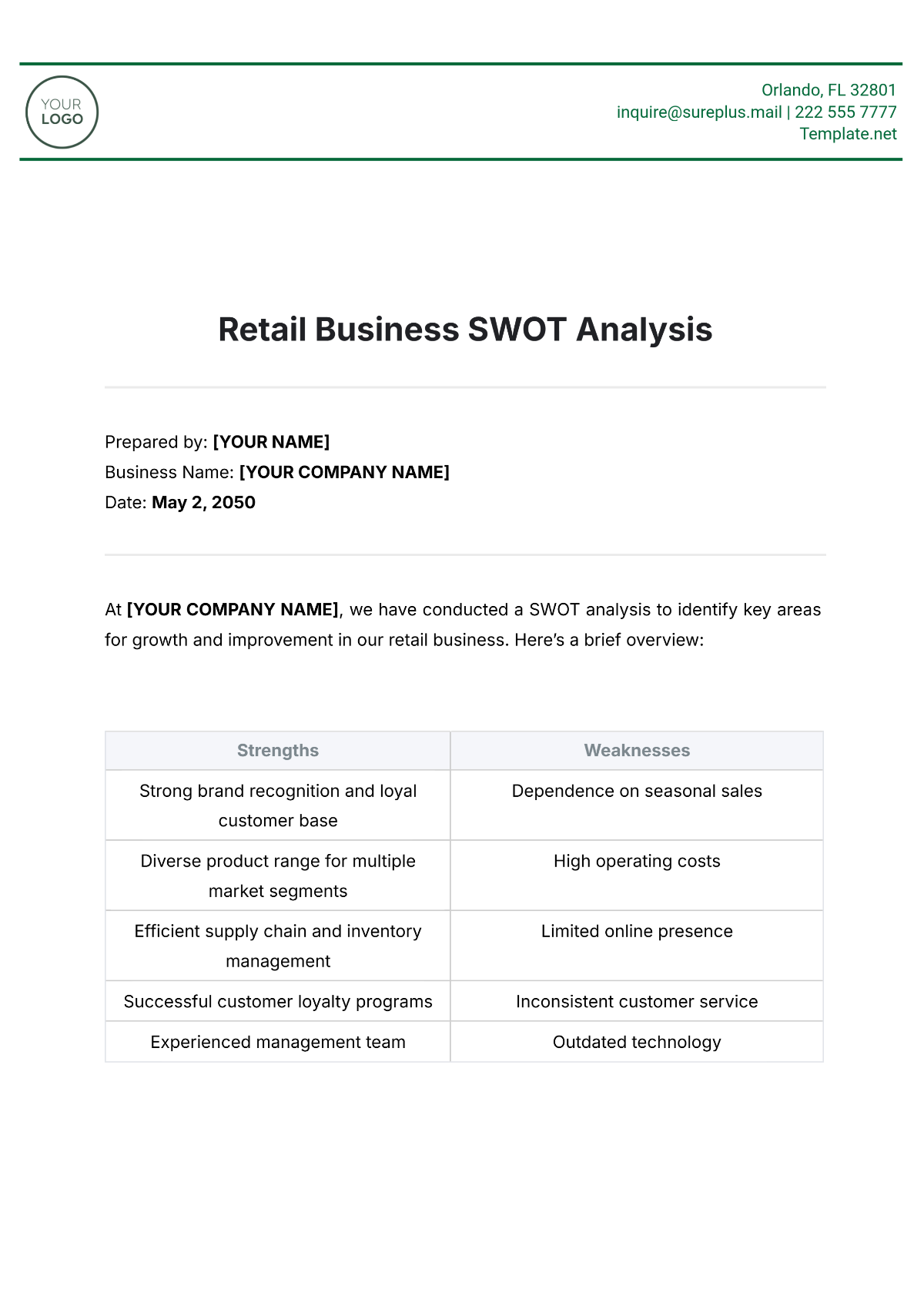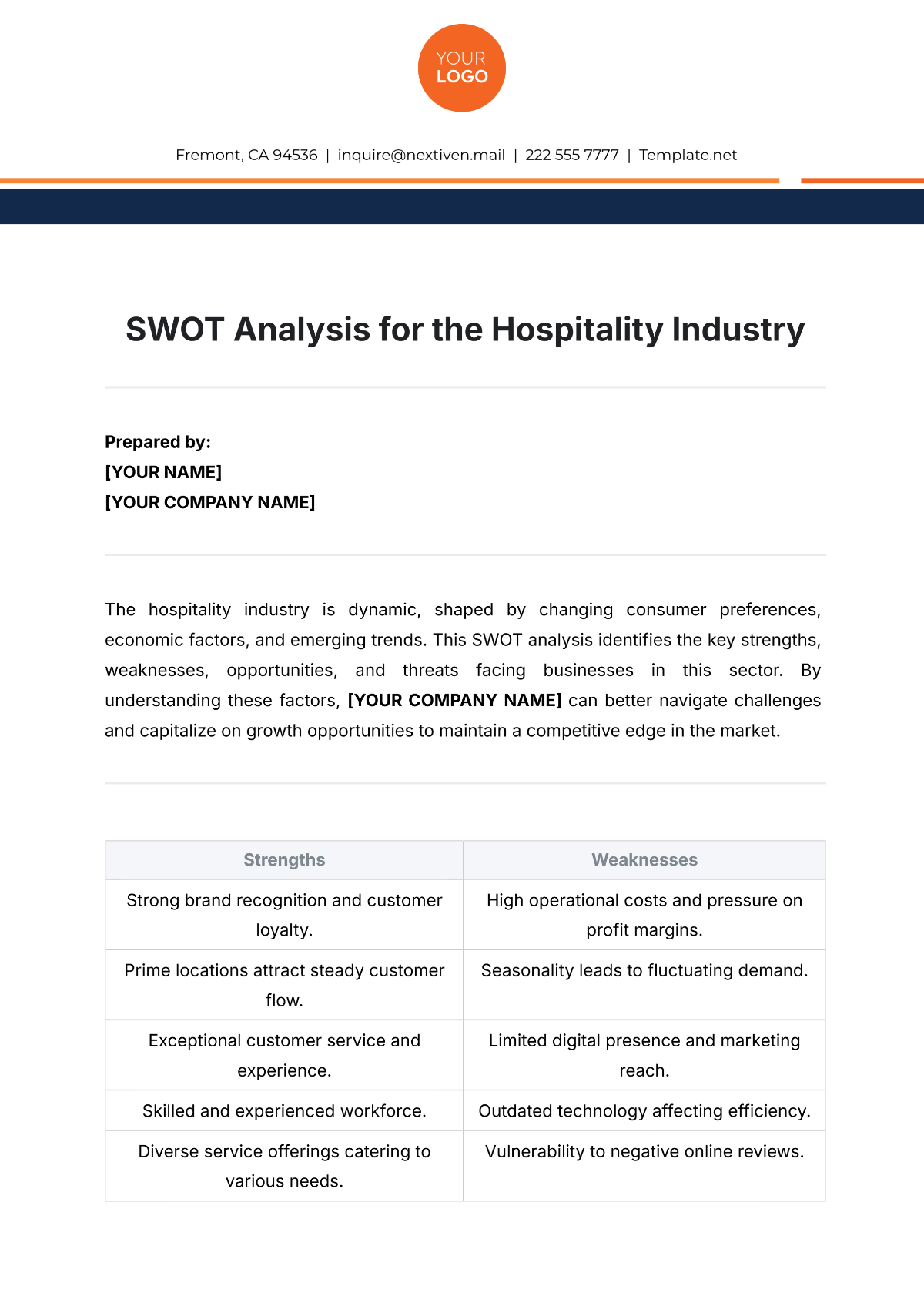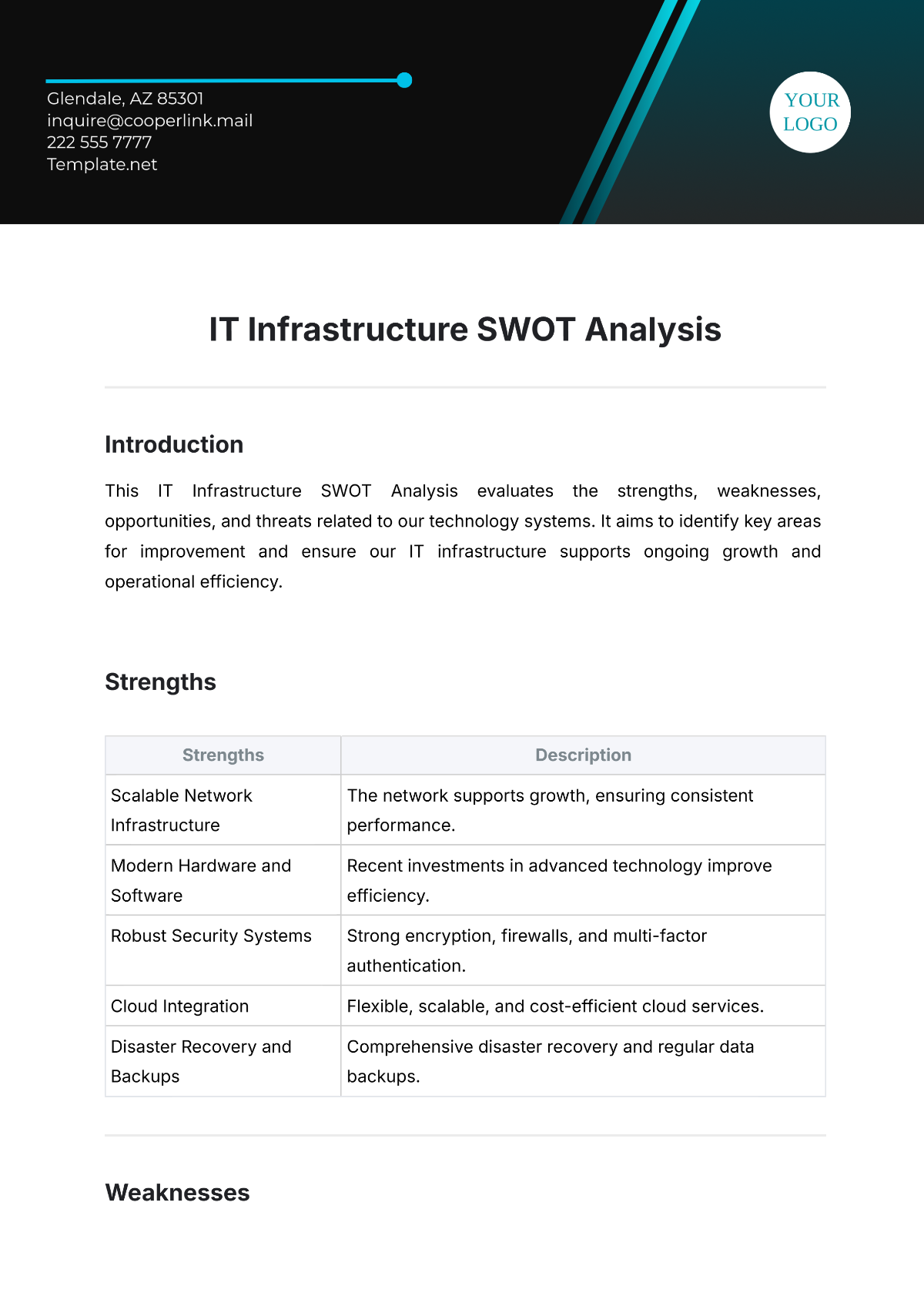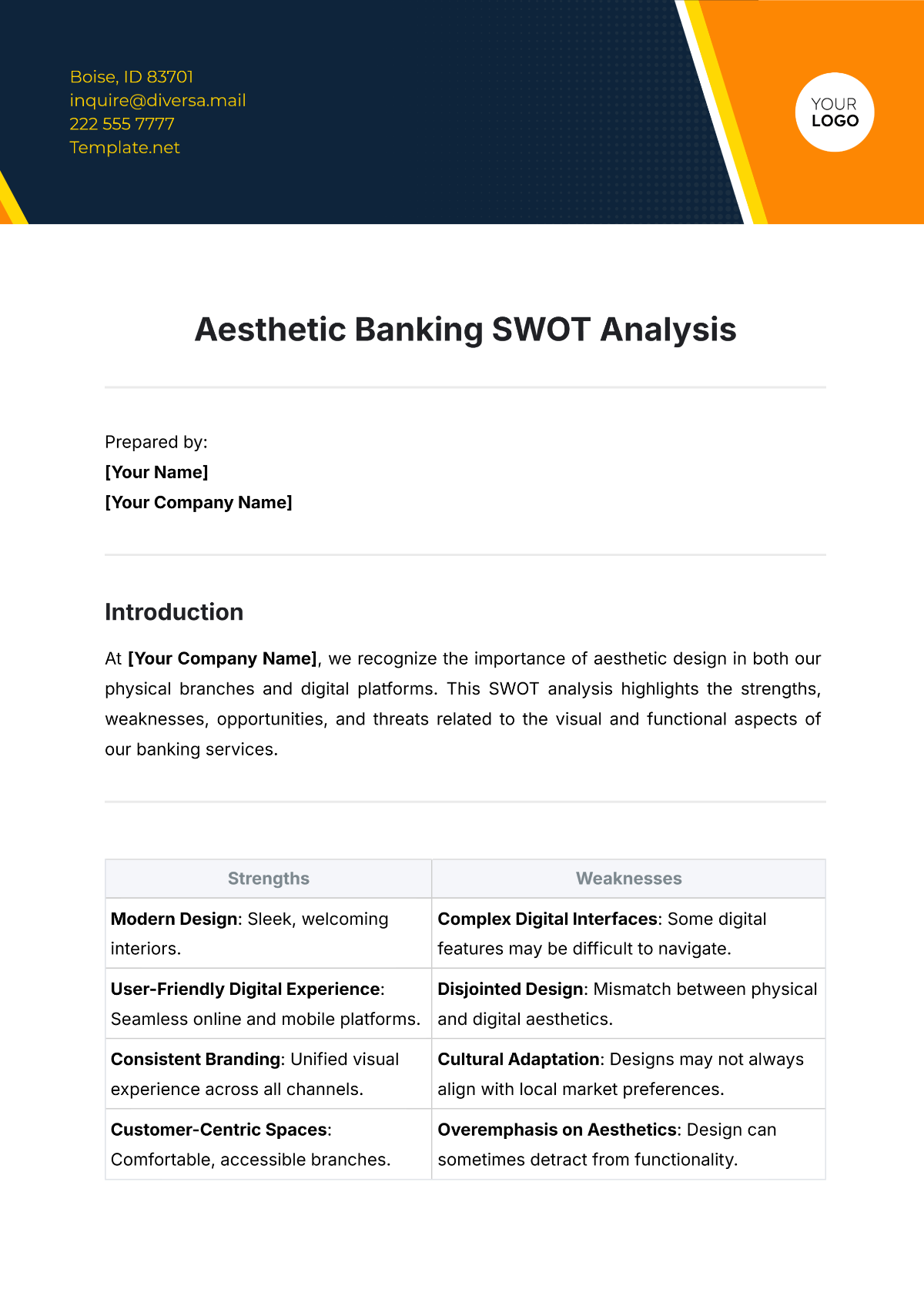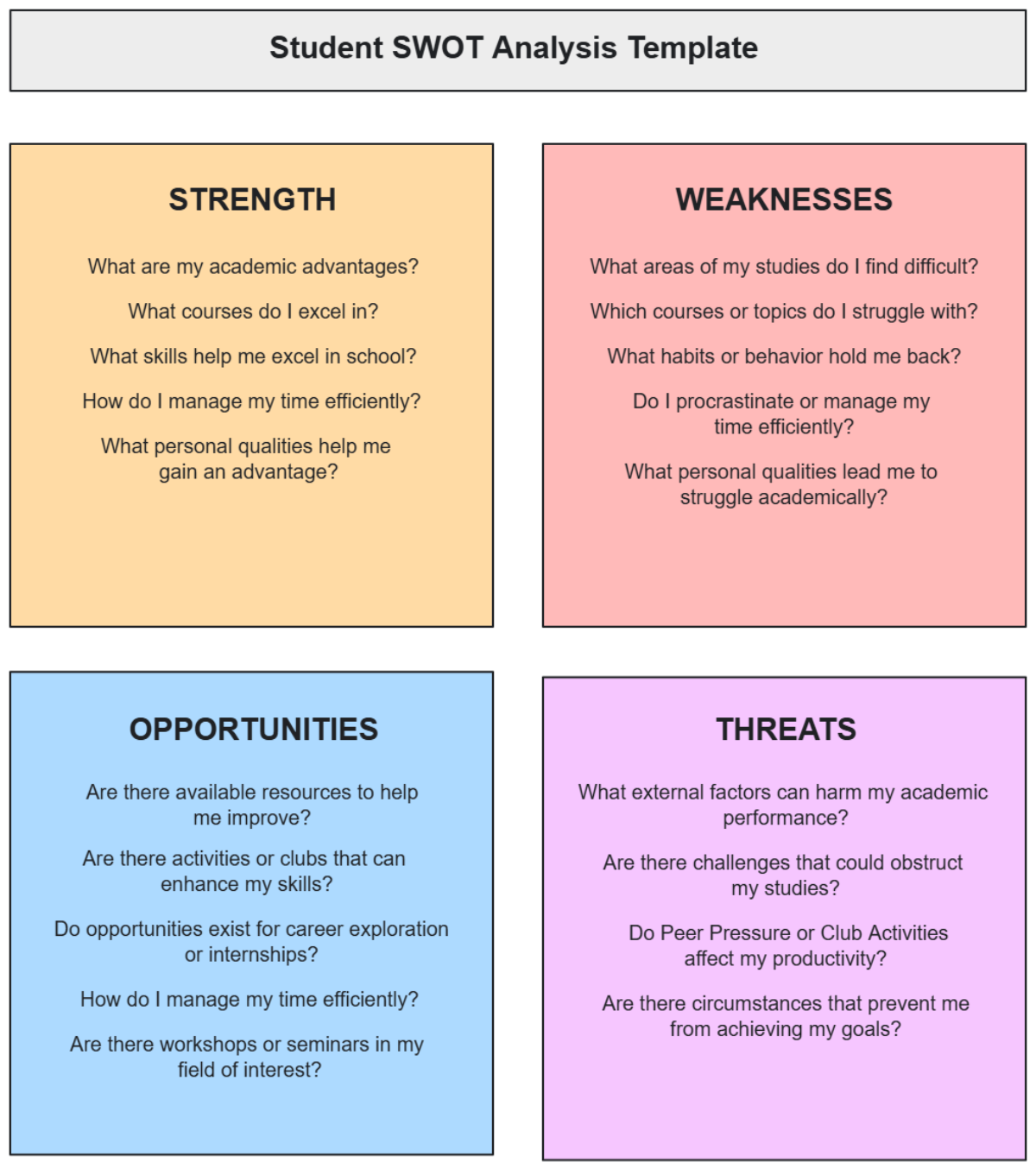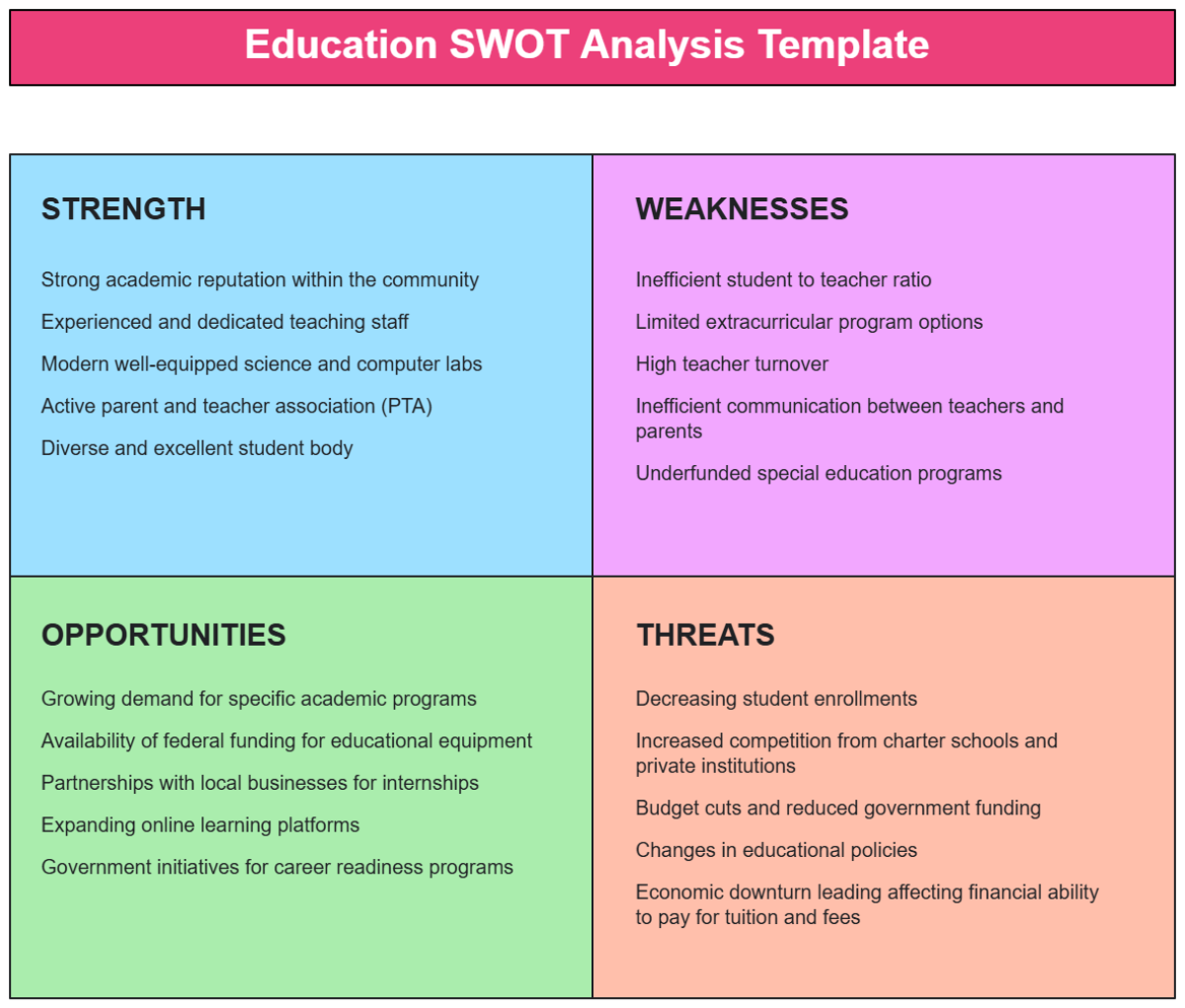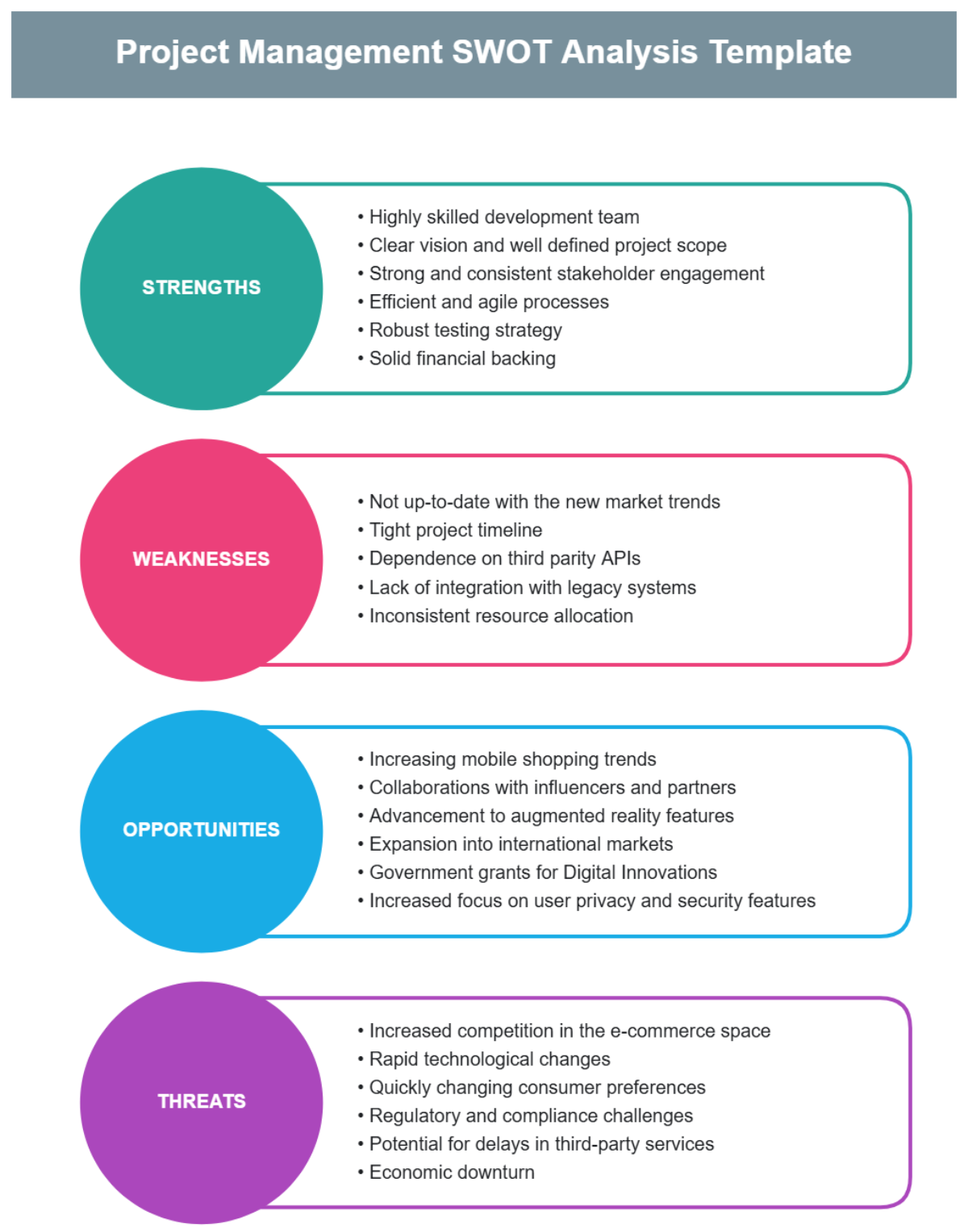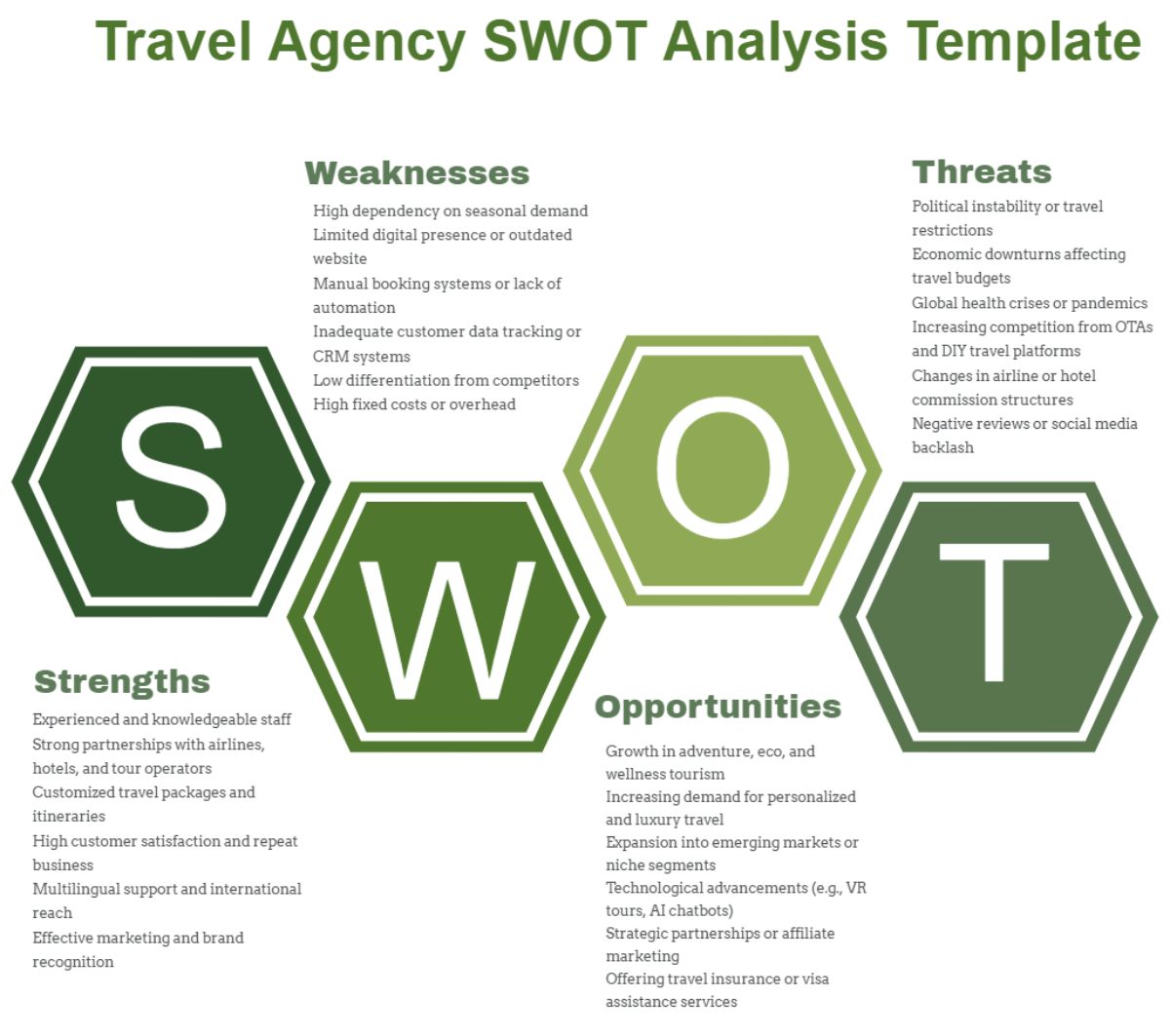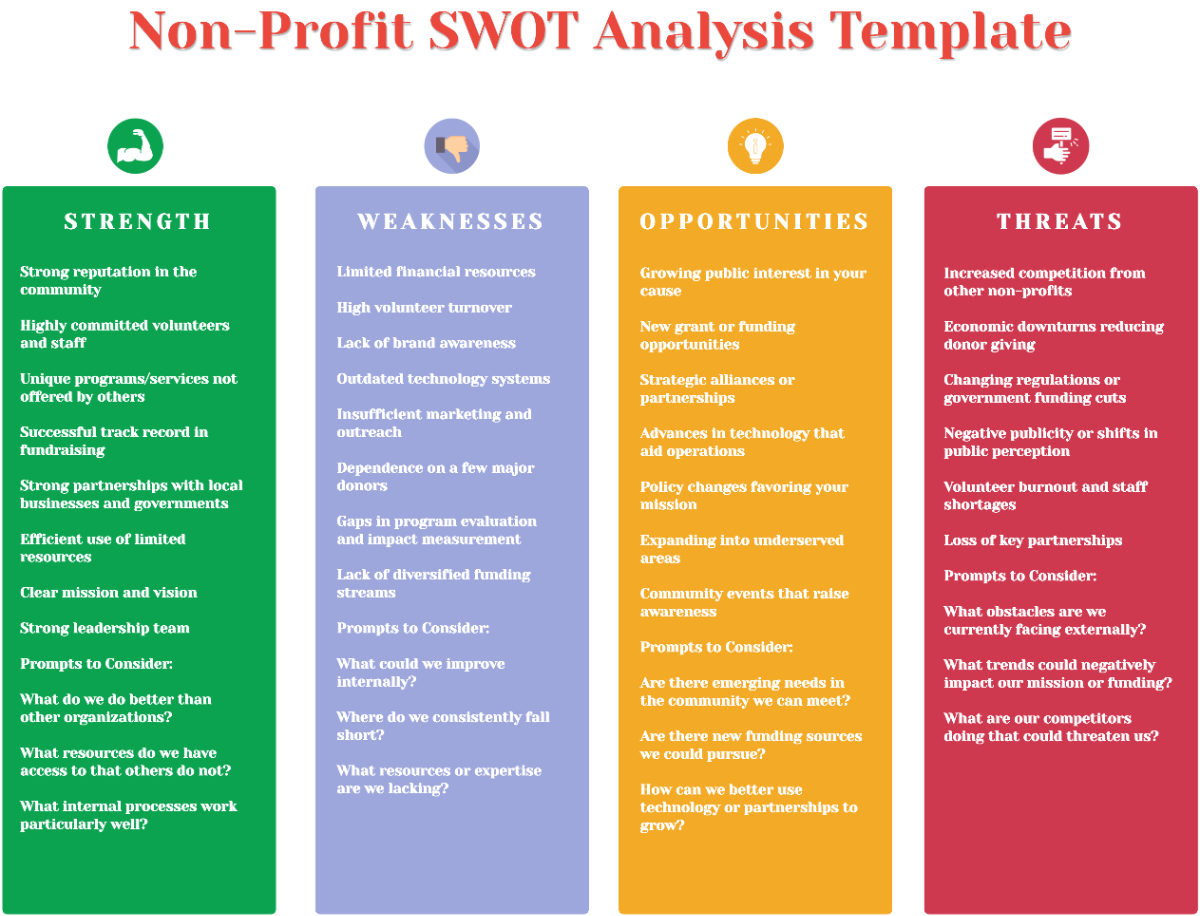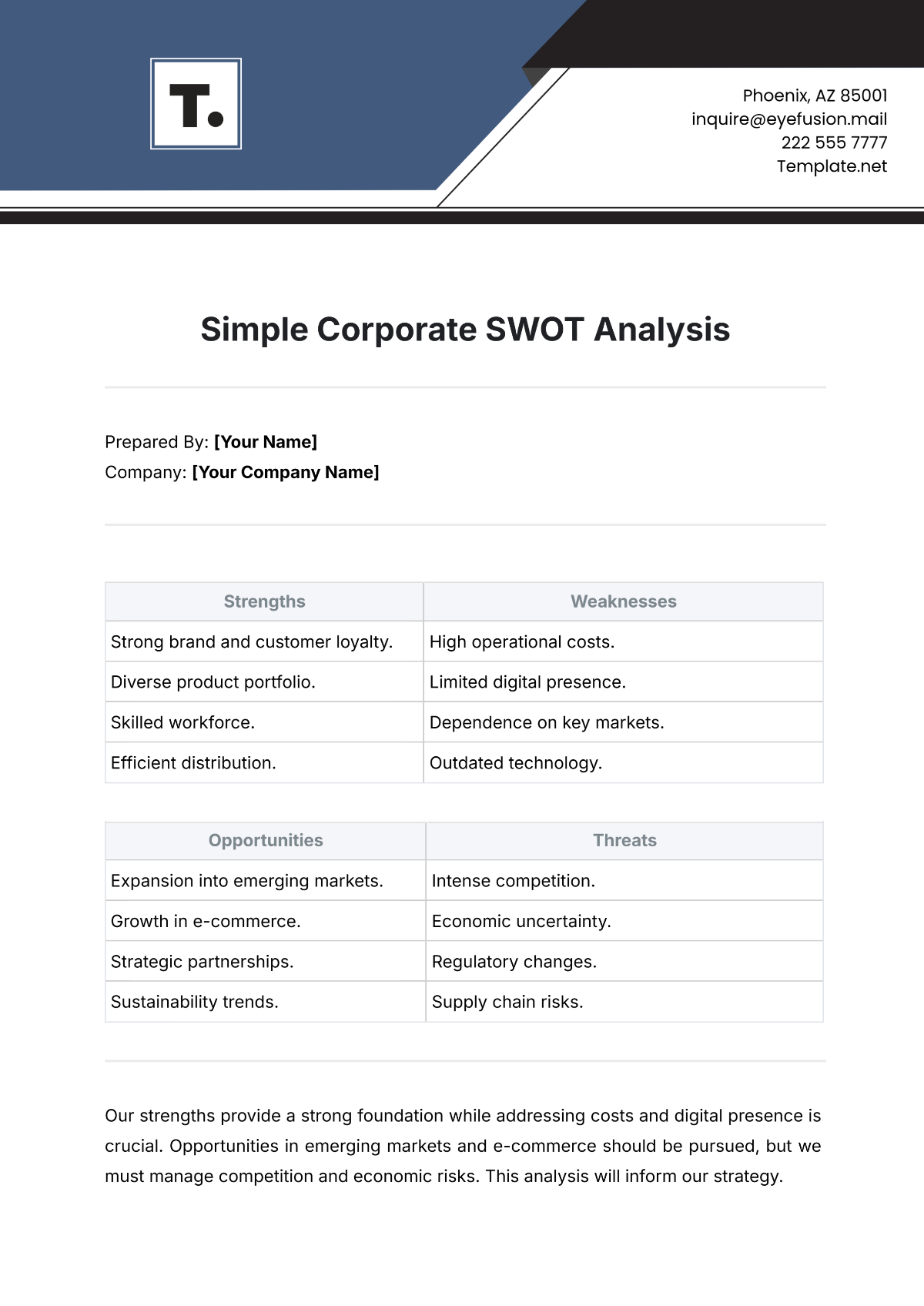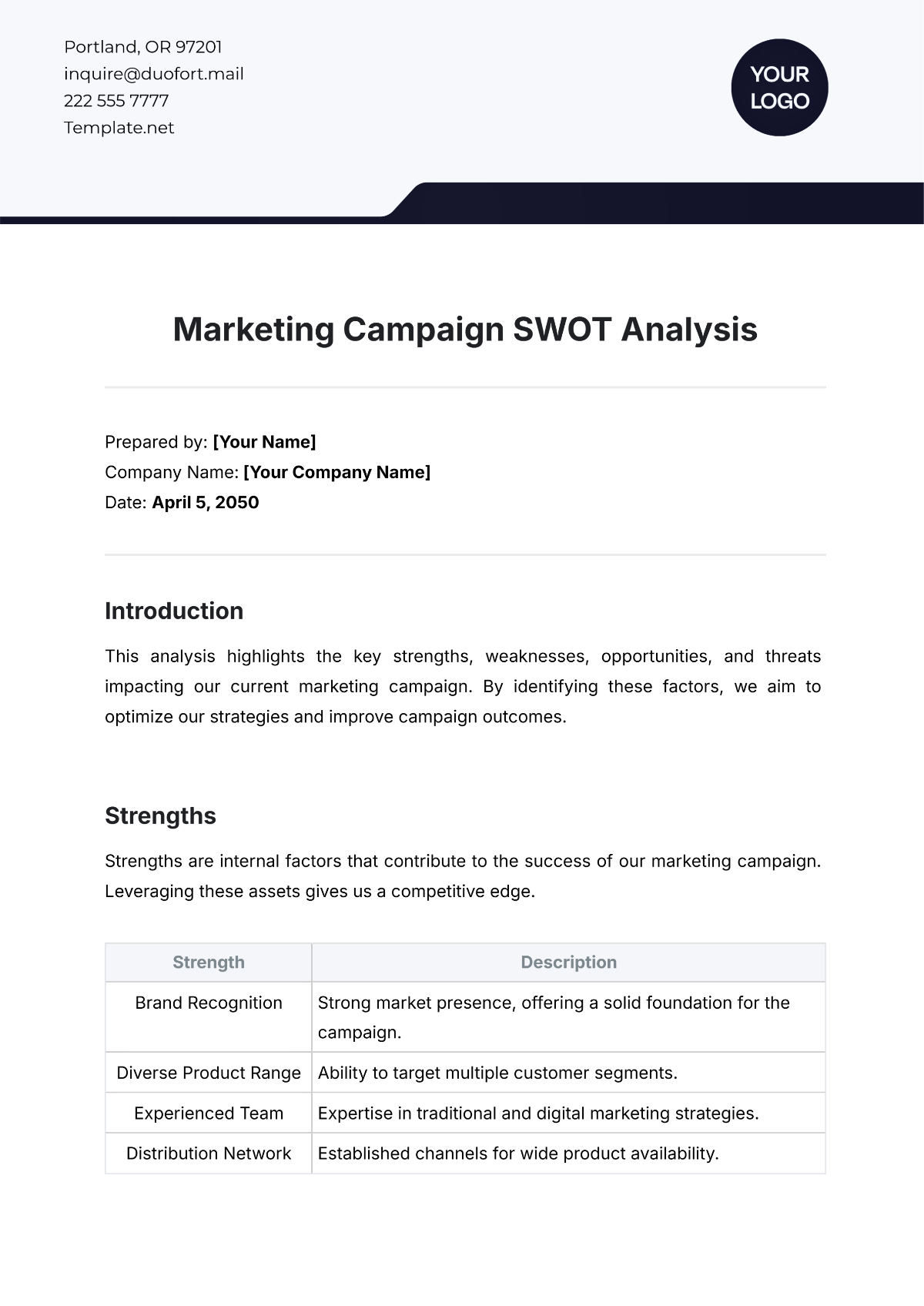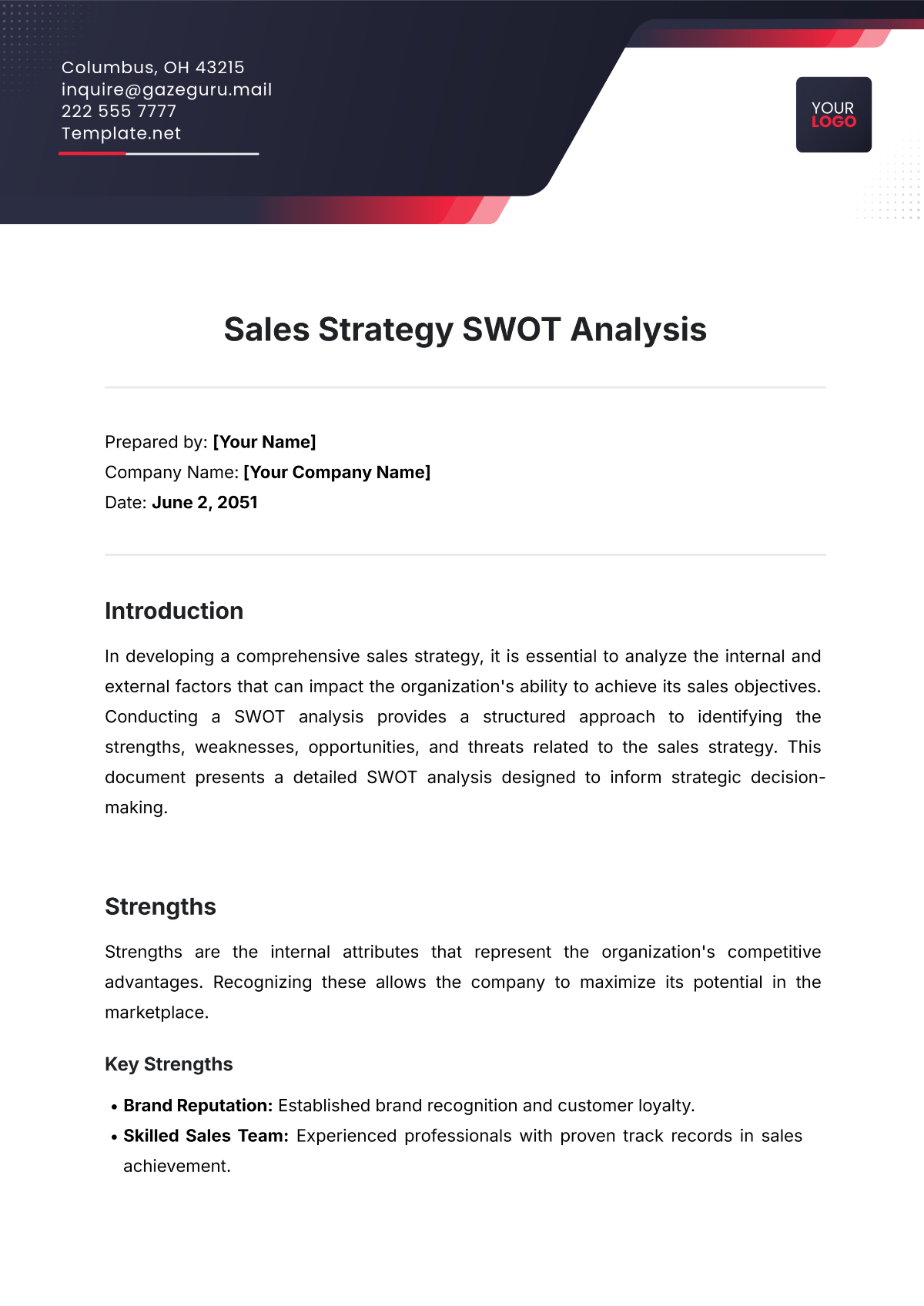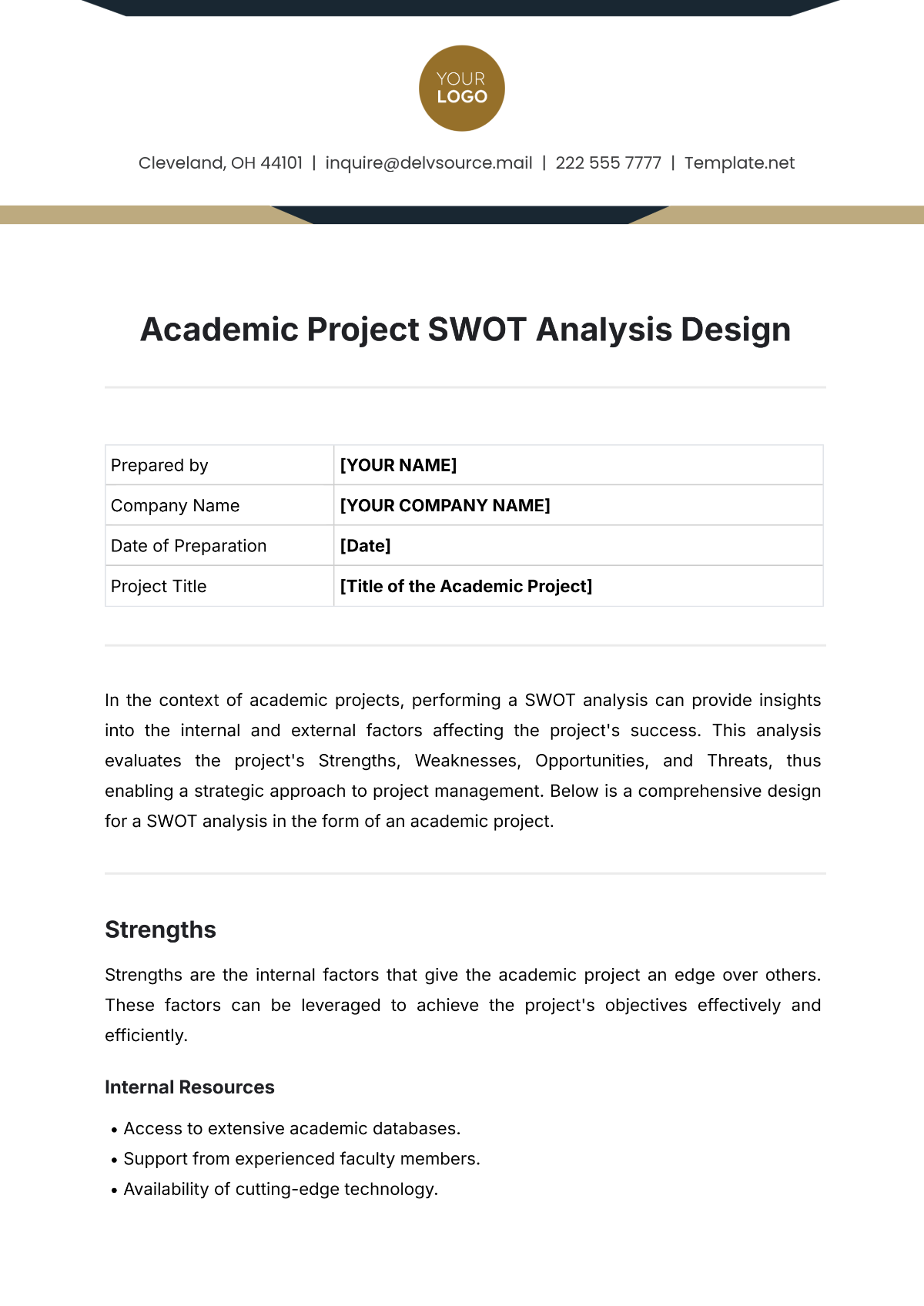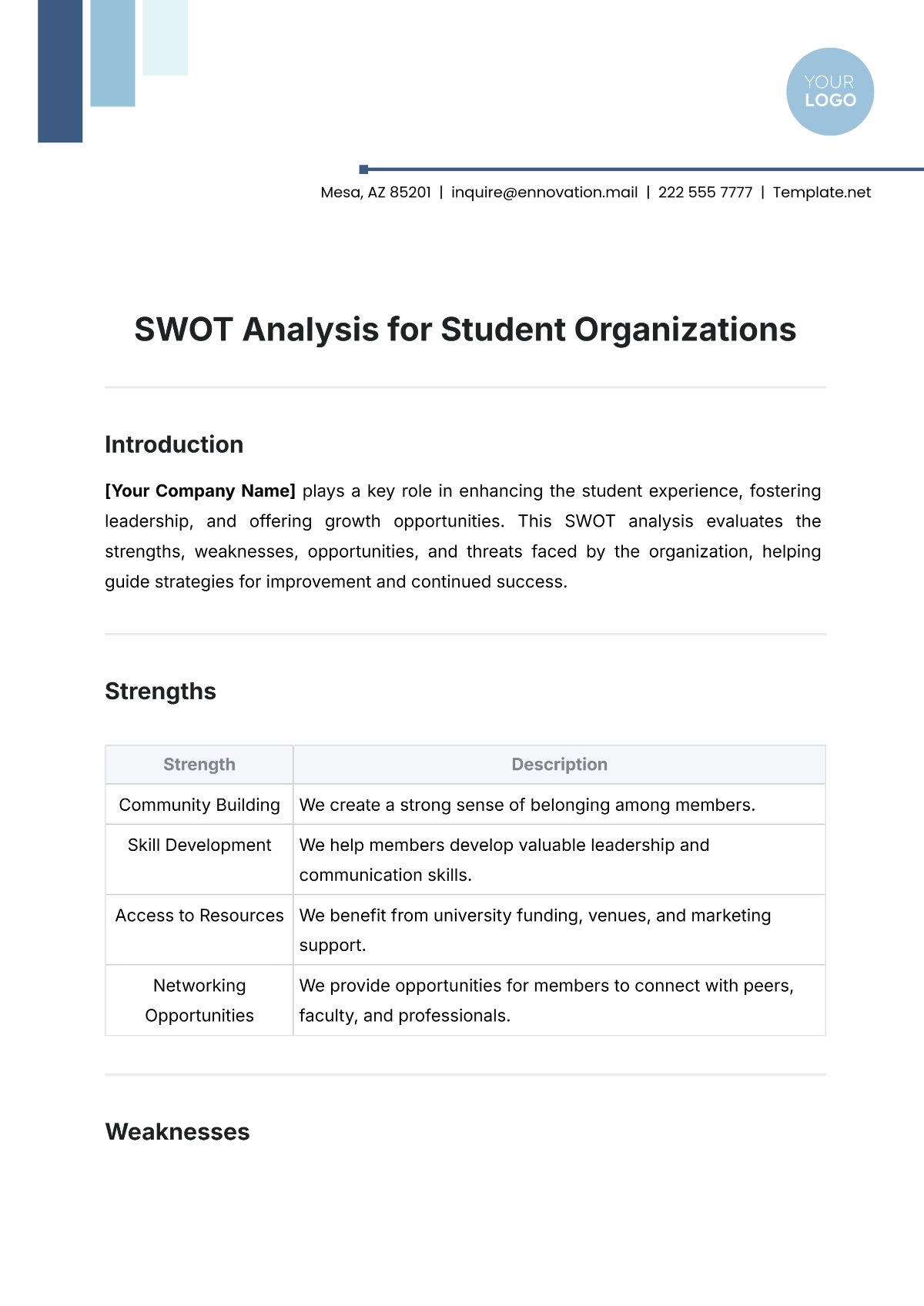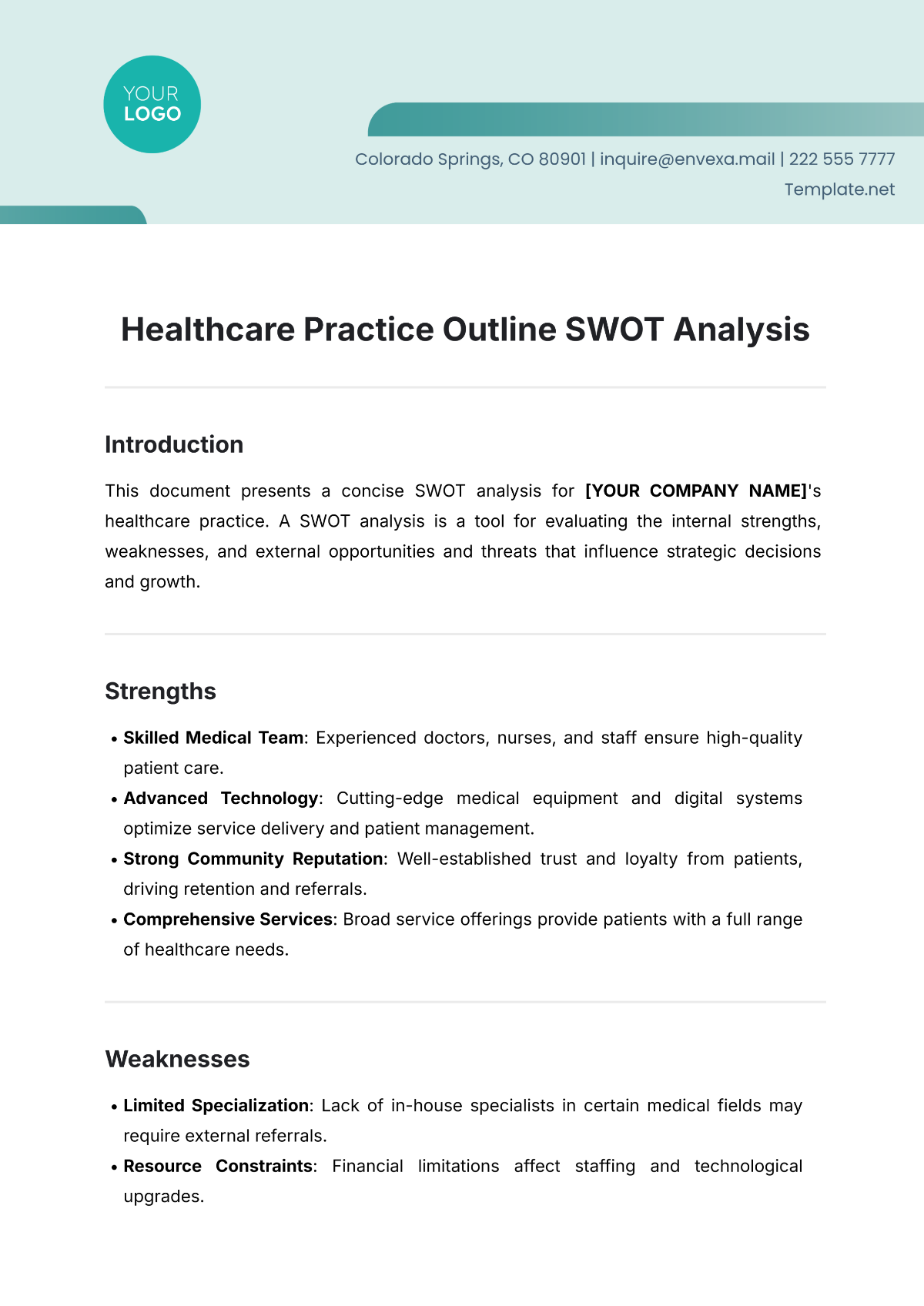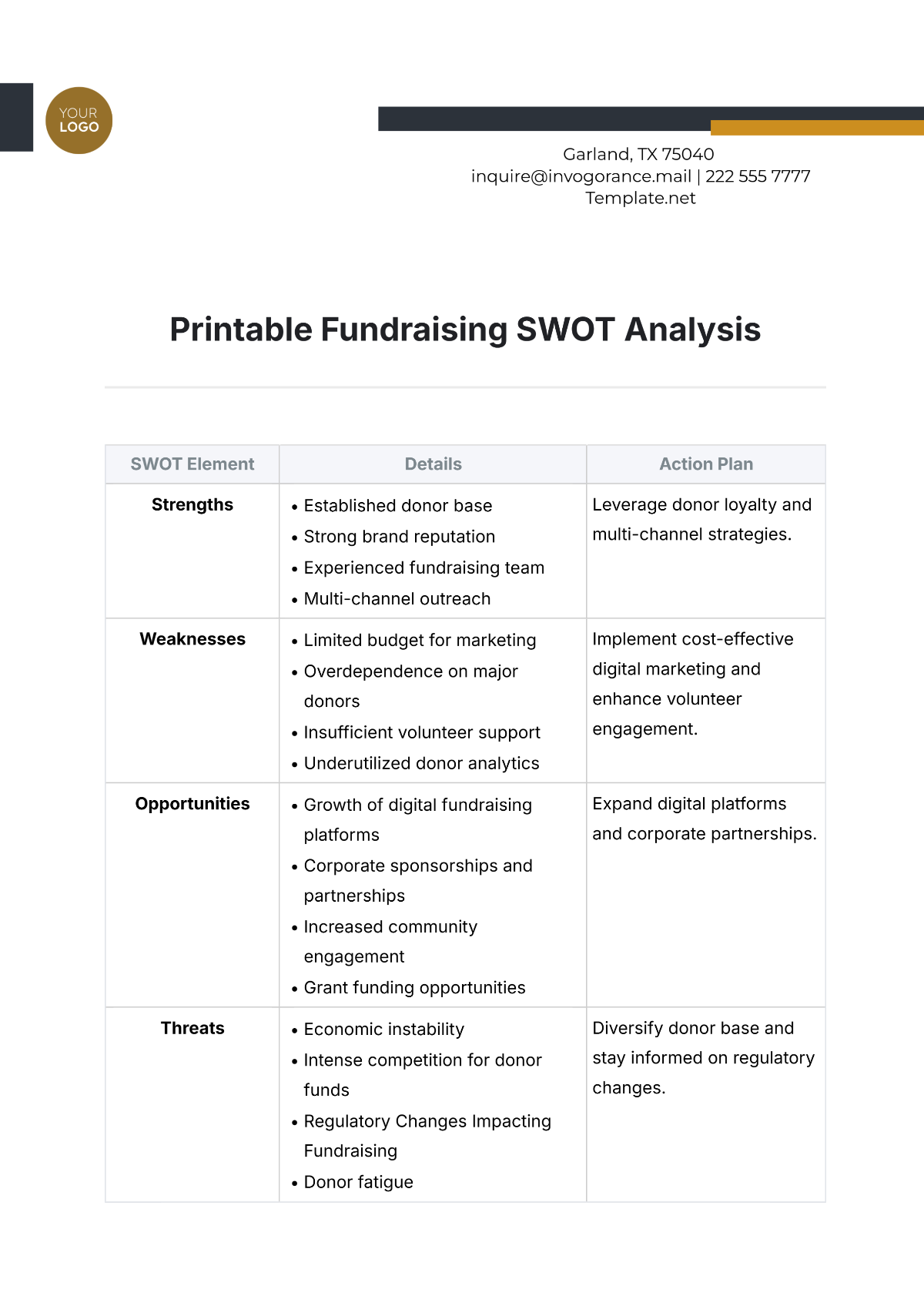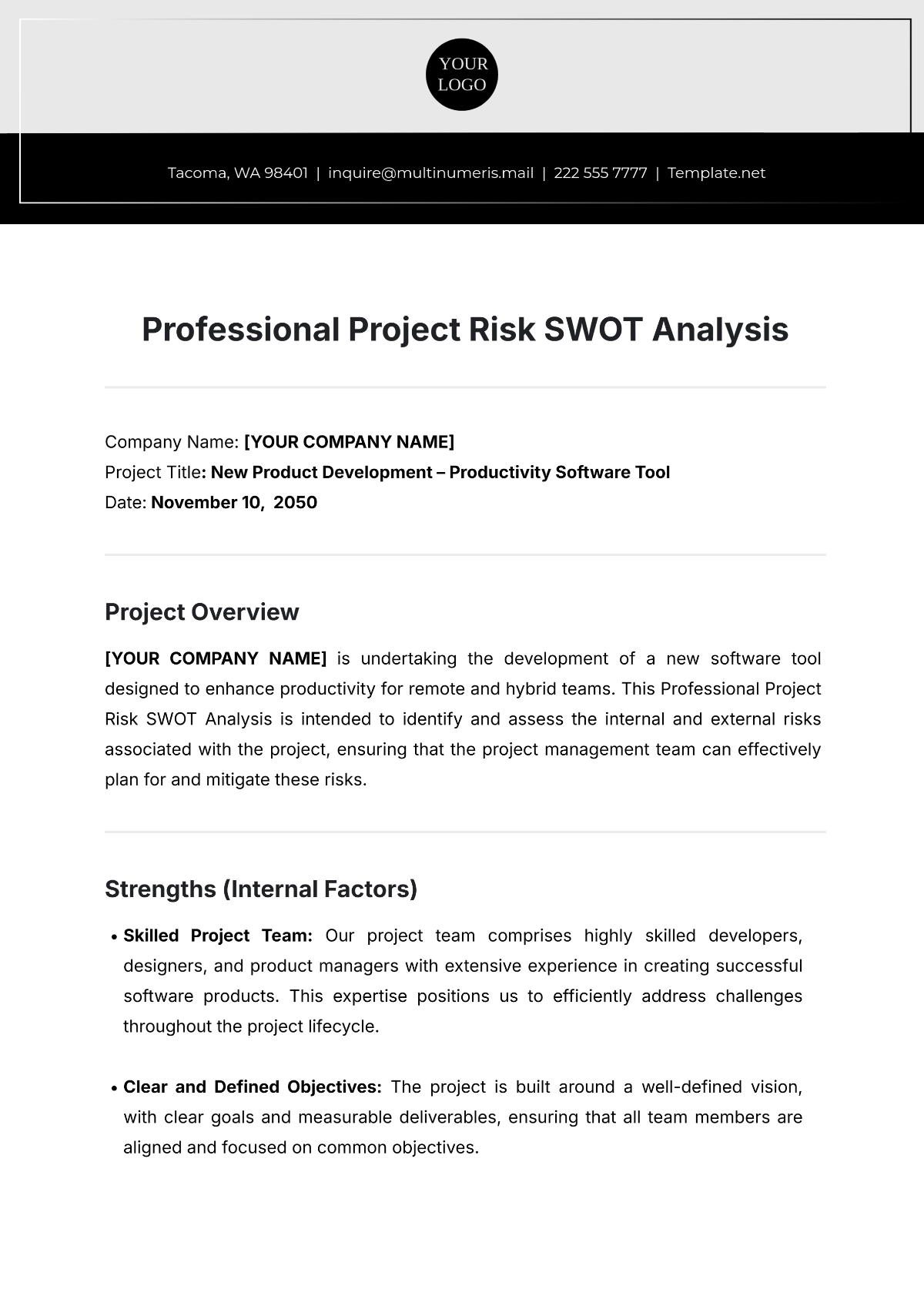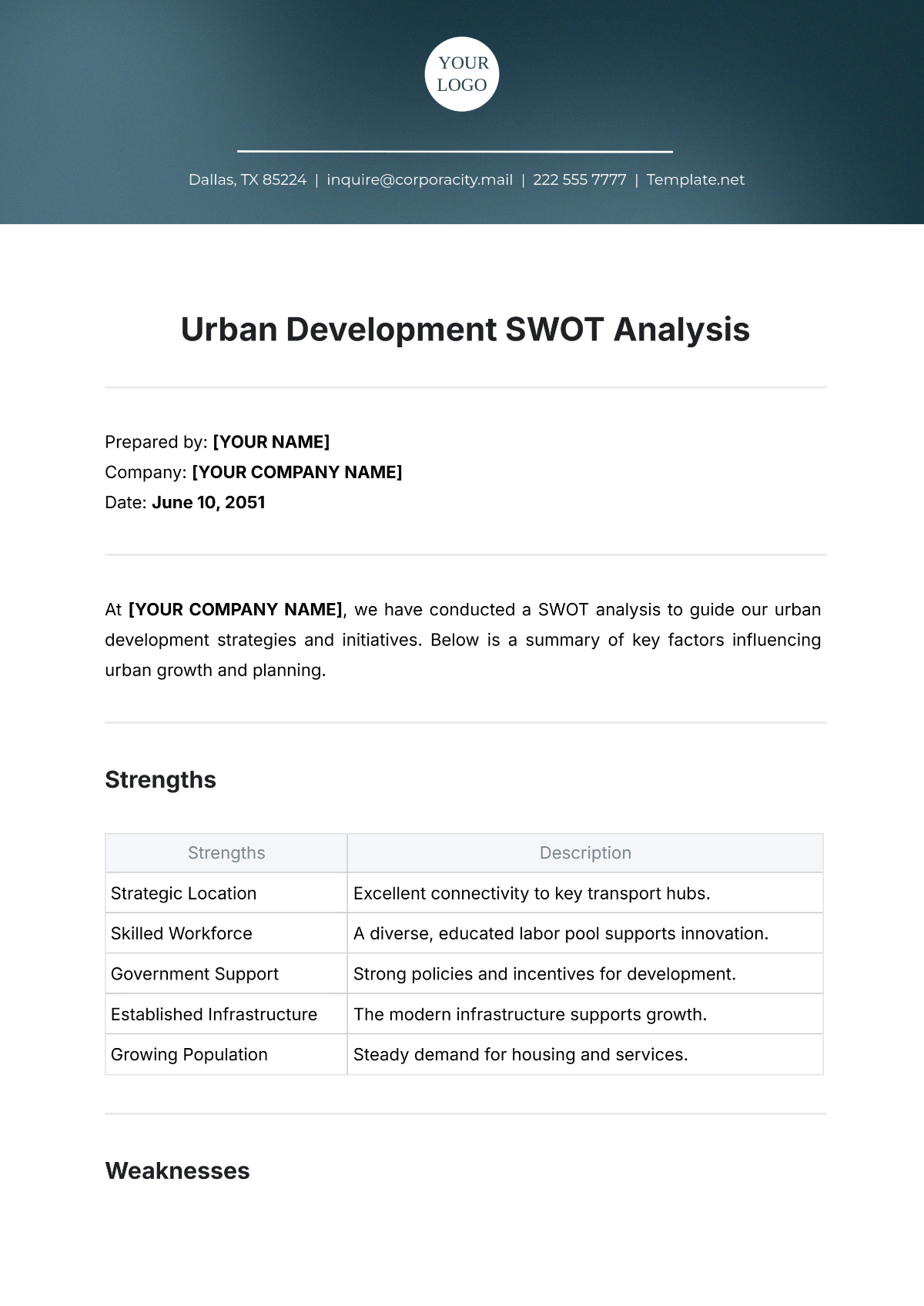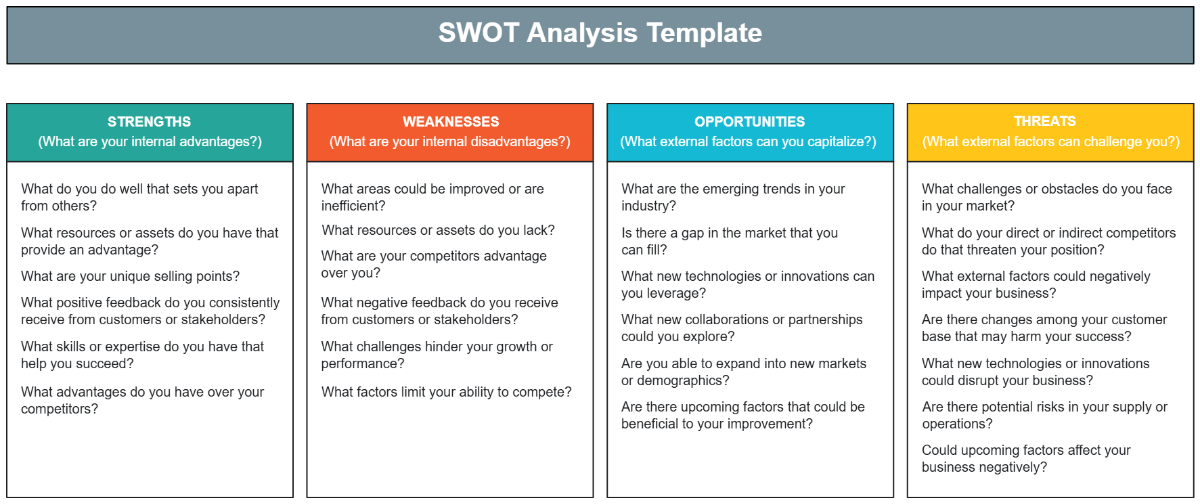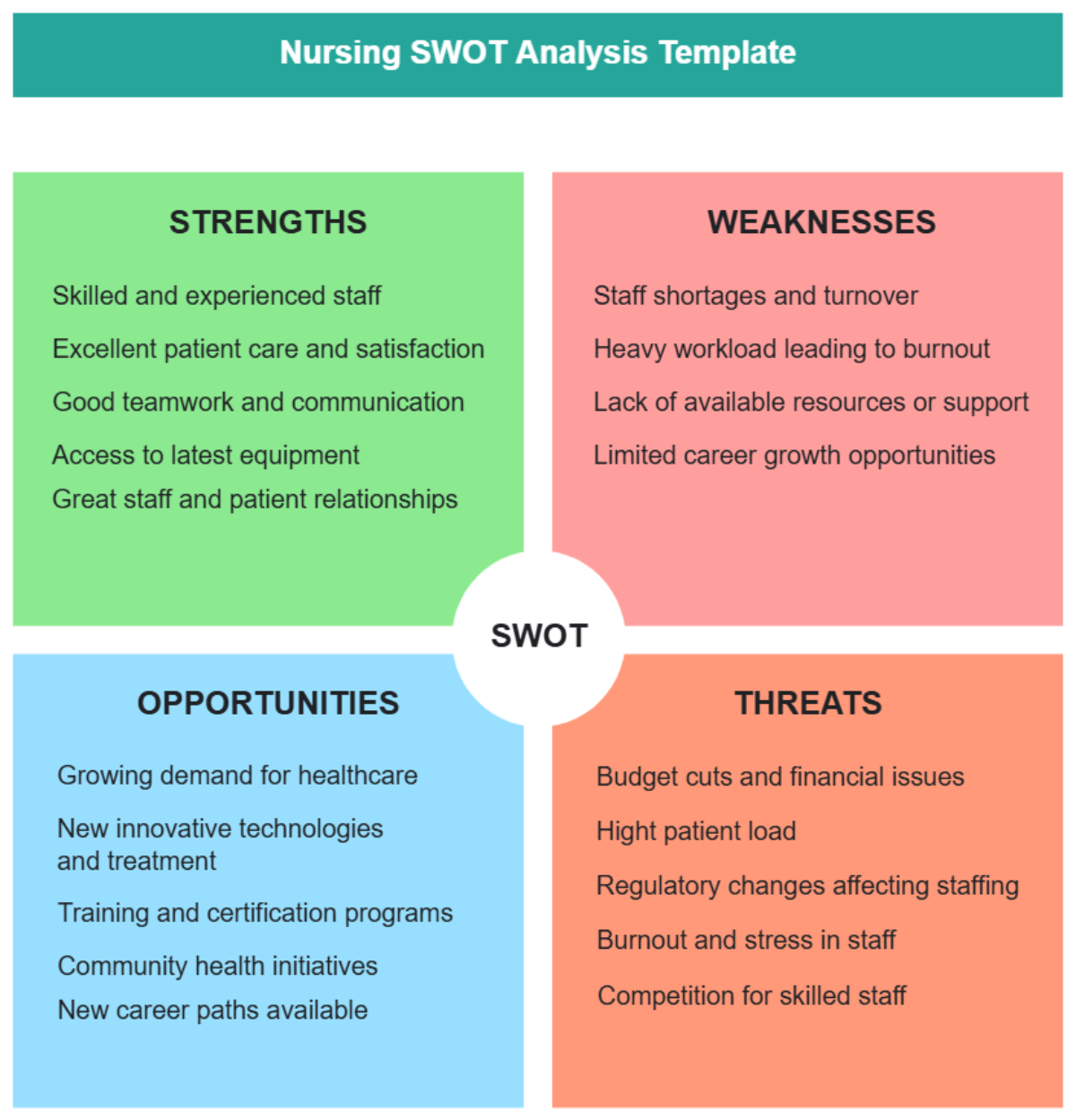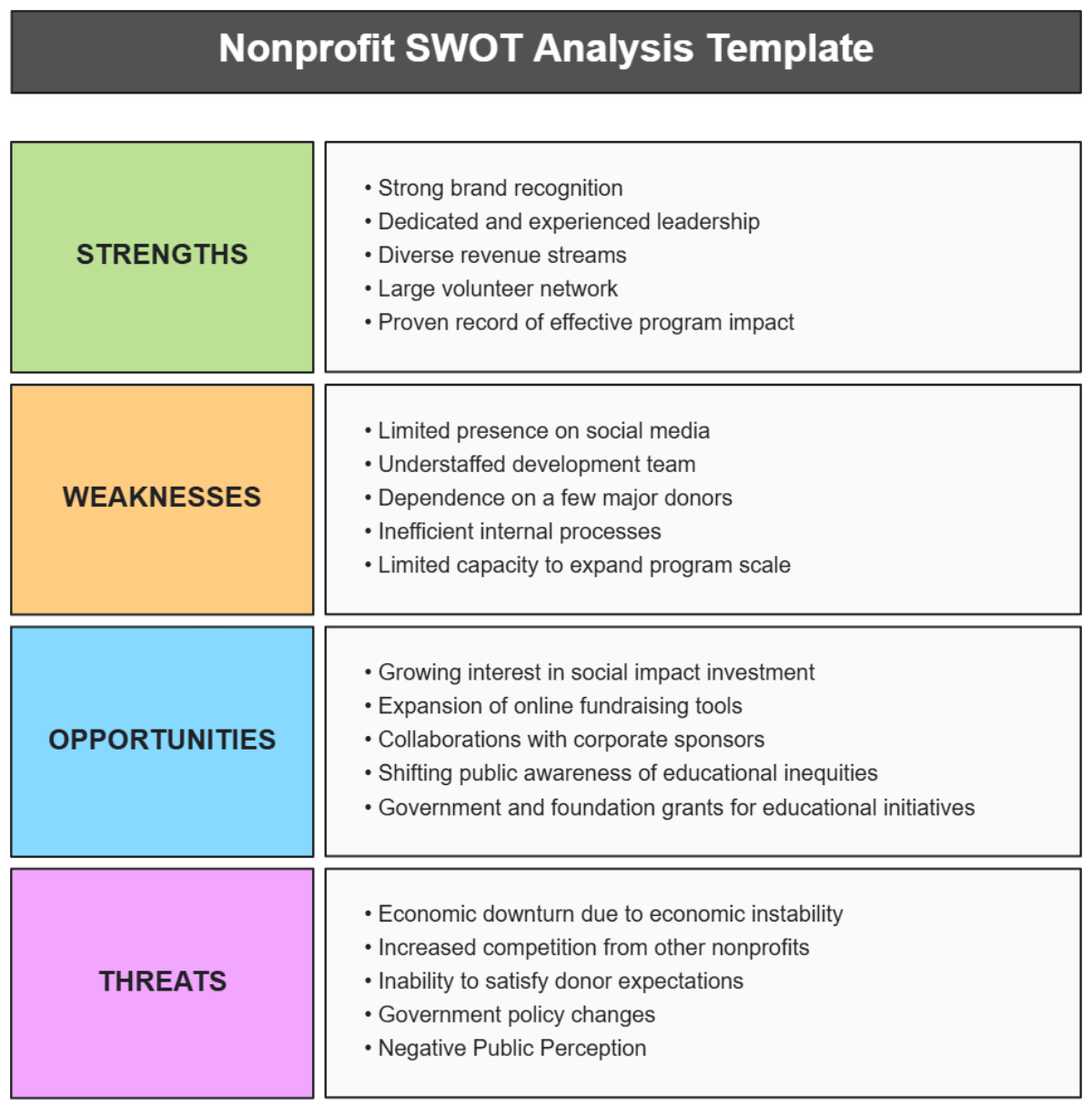Marketing SWOT Analysis for PR Campaigns
I. Introduction
Welcome to the Marketing SWOT Analysis template for PR Campaigns, designed to assist marketing professionals at [Your Company Name] in strategizing and evaluating public relations efforts. This analysis will help you identify key strengths, weaknesses, opportunities, and threats, enabling you to create a robust PR campaign that adheres to US marketing legal and standard guidelines.
II. Strengths
In evaluating the strengths of our PR campaign, it's essential to recognize the internal attributes that give us a competitive edge and contribute to our success. These strengths are the foundation upon which we can build a compelling and effective PR strategy.
Strengths | Description |
Strong Brand Reputation | [Your Company Name] boasts a well-established and reputable brand in the industry, instilling trust and credibility among our target audience. |
Experienced PR Team | Our PR team, led by [Your Name], comprises seasoned professionals with a deep understanding of public relations, ensuring the execution of well-crafted campaigns. |
Innovative Product/Service Offering | We have a unique and innovative product/service portfolio that sets us apart from competitors, offering great content potential for PR initiatives. |
Robust Resources | [Your Company Name] possesses substantial resources, both in terms of budget and manpower, allowing us to execute comprehensive PR campaigns. |
Strong Industry Relationships | Our team has cultivated valuable relationships with key industry influencers and media outlets, facilitating broader media coverage. |
Track Record of Success | We have a proven track record of successful PR campaigns that have achieved tangible results, showcasing our competence in this field. |
Leveraging these strengths, we aim to create PR campaigns that not only reinforce our brand image but also drive tangible business outcomes.
III. Weaknesses
Understanding our weaknesses is crucial for developing effective PR campaigns that address potential challenges and obstacles. Acknowledging and addressing these internal shortcomings will help us improve our overall PR strategy.
Weakness | Description |
Limited Budget | While we have many strengths, we do face budget constraints that may limit the scale and reach of our PR campaigns. This limitation might affect the resources available for media placements and creative production. |
Limited Expertise in Social Media | [Your Company Name] lacks the in-house expertise required for maximizing our presence and impact on social media platforms. This can potentially limit our ability to engage with a broader online audience. |
Internal Conflicts Within the Team | Occasionally, internal conflicts and differences in opinion within our PR team may hinder smooth campaign execution and decision-making processes. These conflicts must be managed effectively. |
Resource Allocation Challenges | Optimally allocating resources for PR campaigns, including staff and time, can be a challenge, which may affect the efficiency of campaign execution. |
Lack of Data Analytics Tools | We lack advanced data analytics tools, which can limit our ability to measure campaign performance and make data-driven decisions. |
Limited Crisis Management Plan | [Your Company Name] does not have a comprehensive crisis management plan in place, which is essential for handling unforeseen PR crises effectively. |
IV. Opportunities
Identifying and capitalizing on opportunities in the external environment is fundamental to a successful PR campaign. Recognizing these opportunities will enable us to align our efforts with market trends and emerging possibilities.
Opportunity | Description |
Growing Interest in Sustainable Products | There is a significant surge in interest and demand for sustainable products and eco-friendly solutions within the consumer goods industry. This presents an opportunity to position [Your Company Name] as a leader in sustainable practices and environmentally conscious products. |
Emerging Trends in Remote Work Culture | The ongoing shift towards remote work culture presents an opportunity for [Your Company Name] to offer thought leadership and expertise on remote work productivity and wellness. This aligns with our PR campaign message of promoting work-life balance. |
Expansion into International Markets | [Your Company Name] has successfully established a strong presence in the domestic market. Expanding into international markets, particularly in Asia, presents an opportunity to tap into new customer segments and diversify our customer base. |
Advancements in Virtual Reality (VR) Technology | The growing adoption of VR technology in various industries provides opportunities to create immersive PR experiences. We can leverage VR to engage our audience in innovative ways and showcase our products/services. |
Shift in Customer Behavior - Online Shopping | With the increasing preference for online shopping, we have an opportunity to strengthen our online presence and launch targeted PR campaigns to capture a larger share of the e-commerce market. |
By capitalizing on these opportunities, [Your Company Name] can enhance the effectiveness of its PR campaigns, connect with a broader audience, and remain at the forefront of industry trends.
V. Threats
Identifying potential threats is crucial for proactive planning and risk mitigation in PR campaigns. Understanding these external factors that may negatively impact our efforts allows us to develop strategies to counteract or navigate them effectively.
Threat | Description |
Intense Competitive Pressure | Our industry is experiencing increasing competition from both established players and new entrants. This heightened competition can make it challenging to stand out and maintain market share. |
Economic Instability | Economic downturns or market volatility can impact consumer spending habits and affect the budget available for PR campaigns. Economic uncertainties pose a threat to campaign funding. |
Regulatory Changes | Upcoming changes in industry regulations or compliance requirements may necessitate adjustments to our PR strategies and messaging. Failure to adapt could result in legal risks and reputation damage. |
Rapid Technological Advancements | The rapid pace of technological advancements can pose a threat if we fail to keep up. Our PR campaigns must stay aligned with evolving technology trends to remain relevant. |
Data Privacy Concerns | Heightened concerns around data privacy and security could lead to stricter regulations and increased scrutiny. This may affect our data-driven PR strategies and targeting capabilities. |
Natural Disasters and Pandemic Risks | Natural disasters or unforeseen events, such as a pandemic, can disrupt campaign execution and impact our ability to reach our target audience effectively. |
VI. Target Audience Analysis
Understanding your target audience is paramount in crafting successful PR campaigns. A precise understanding of their demographics, psychographics, and preferences will allow us to tailor our messaging and strategies effectively.
Demographics | Psychographics |
Age Our primary target audience falls in the 25-40 age range. Gender We target both male and female audiences, with a slight skew towards females. Location Our audience is primarily located in urban and suburban areas in the United States. Income Level Our target audience typically falls within the $50,000 to $100,000 annual income bracket. | Lifestyle Our audience values an active and healthy lifestyle, with an emphasis on outdoor activities and wellness. Values They are aligned with values such as sustainability and environmental consciousness. Interests Our target audience shows interest in technology, outdoor adventures, and sustainable living. Behavior They exhibit behaviors such as online shopping for eco-friendly products and active social media engagement, particularly on Instagram and Pinterest. |
Consumer Needs | Communication Preferences |
Our audience seeks high-quality, innovative products that align with their sustainable living values. Pain Points They face challenges related to finding eco-friendly products that meet their performance expectations. Motivations Their motivations include achieving a balanced lifestyle and minimizing their environmental footprint. | Our target audience prefers to receive information through social media platforms, particularly Instagram and Pinterest, where they actively follow eco-conscious influencers. They engage with content that is visually appealing, informative, and showcases the eco-friendliness and performance of products. Ideal Engagement Times They are most active and receptive during evenings and weekends when they have leisure time to explore content. |
By thoroughly analyzing our target audience, we can create PR campaigns that resonate with their needs, values, and preferences, ultimately driving engagement and loyalty.
VII. Competitor Analysis
Understanding our competitors' PR efforts is essential for gaining a competitive edge and identifying opportunities to differentiate ourselves. Analyzing their strategies, strengths, and weaknesses will guide us in shaping effective PR campaigns.
Competitor | Strengths | Weaknesses |
A |
|
|
B |
|
|
C |
|
|
VIII. Messaging and Content Strategy
Crafting compelling messaging and content is at the core of successful PR campaigns. Our strategy in this area should align with our goals and resonate with our target audience.
Key Messages |
|
Content Themes |
|
Content Types |
|
Content Calendar |
|
Channel Strategy |
|
IX. Media and Channel Analysis
In this digital age, our media and channel strategy will be comprehensive and adaptive. We'll harness the power of social media platforms, such as Instagram and Twitter, for real-time engagement with our audience. Additionally, traditional media outlets will be leveraged for press releases and feature articles, ensuring a broad reach. Email newsletters will play a role in direct audience communication, complemented by influencer collaborations for added authenticity. Through this diversified approach, we aim to maximize our PR campaign's visibility and effectiveness.
X. Budget and Resource Allocation
Before delving into the details of our PR campaign's budget and resource allocation, it's essential to set the stage for a strategic approach. In this section, we'll outline how financial planning and resource management will support our campaign's objectives and overall success.
Category | Allocation ($) |
Media Placements | [Amount] |
Creative Production | [Amount] |
Staffing (Salaries and Benefits) | [Amount] |
Contingency Fund | [Amount] |
Analytics Tools and Software | [Amount] |
Miscellaneous Expenses | [Amount] |
Total Budget | [Amount] |
XI. Timeline and Milestones
In the following section, we outline a timeline and milestones for our PR campaign. This structured approach to scheduling key activities and objectives is crucial for ensuring that our campaign progresses smoothly and that we stay on track to meet our goals.
Milestone | Timeline |
Campaign Planning | Month 1 |
Content Creation | Months [00]-[00] |
Media Outreach | Months [00]-[00] |
Social Media Engagement | Months [00]-[00] |
Influencer Collaborations | Months [00]-[00] |
PR Campaign Launch | Months [00]-[00] |
Performance Evaluation | Months [00]-[00] |
